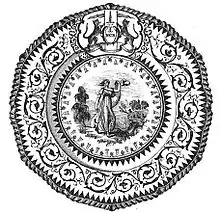Thomas Baxter (painter)
Thomas Baxter Jnr. (17 February 1782 – 18 April 1821) was an English porcelain painter, and a watercolour painter and illustrator.[1]



Life and work
Baxter (of whom an account is given in 'A Century of Potting in the City of Worcester' by R. W. Binns, 1877[2]) was born in Worcester, the son of a china painter and gilder,[3] who had workshops in London connected with the Worcester china works.[4] Baxter received his first instruction in art from his father. He was a fellow student of Benjamin Haydon at the Royal Academy, as appears from a letter written by Baxter to Haydon in 1819. He was patronised by Lord Nelson, and was often employed by him in making sketches at his estate in Merton; He also painted for him a rich dessert service.[1]
In his paintings upon china he introduced figures from the works of Reynolds, West and other well-known painters. In 1814 he left Worcester and established an art school in London, and had pupils who were afterwards distinguished in their special line. In 1816 he worked for the Cambrian Pottery at Swansea, and was there three years. His great work at that place was a "Shakespeare Cup" (from its description, remarkable more for ingenuity than for good taste). In 1819, he returned to Worcester, and was again employed at the Royal Porcelain Works (owned by Flight and Barr), and afterwards at Robert Chamberlain's factory. He was described as "the most accomplished artist who painted Worcester porcelain in the first half of the eighteenth century".[1][5]
He also made drawing's for John Britton's book on Salisbury Cathedral, wrote and illustrated a book on ancient costume,[6] and made two "very clever" copies of the 'Portland vase.'[1]
Baxter died in London, 18 April 1821.[1]
References
- "Bakter, Thomas (1782-1821)". Dictionary of National Biography. London: Smith, Elder & Co. 1885–1900. pp. 437–8.
- Richard William Binns. A century of potting in the city of Worcester, being the history of the Royal Porcelain Works, from 1751 to 1851 (B. Quaritch, 1865)
- Pottery industry jobs - Gilder ("the local history of Stoke-on-Trent, England").
- The Baxter ceramic studio (watercolour, c. 1810).
- Binns, 1836, p134.
- Thomas Baxter. An illustration of the Egyptian, Grecian, and Roman costume (London, 1810)
Attribution:
 This article incorporates text from a publication now in the public domain: Bryan, Michael (1886). "Baxter, Charles". In Graves, Robert Edmund (ed.). Bryan's Dictionary of Painters and Engravers (A–K). Vol. I (3rd ed.). London: George Bell & Sons.
This article incorporates text from a publication now in the public domain: Bryan, Michael (1886). "Baxter, Charles". In Graves, Robert Edmund (ed.). Bryan's Dictionary of Painters and Engravers (A–K). Vol. I (3rd ed.). London: George Bell & Sons.
Further reading
- James Elmes (Ed). The Magazine of the fine arts, Volume 1 p218-20 (London, 1821)
- John O. Wilstead, Bernard Morris. Thomas Baxter: the Swansea years, 1816-1819 (Gomer, 1997)
External links
- Thomas Baxter on Artnet
- Porcelain pieces decorated by Thomas Baxter jnr. (Los Angeles County Museum of Art)
- Jubal cup (Glynn Vivian Art Gallery)
- Porcelain plate (E6089) (National Maritime Museum)
- Baxter portrait mug (Worcester porcelain museum)
- A pair of English porcelain, cobalt-blue, ground spill vases (c. 1815 - Christie's)